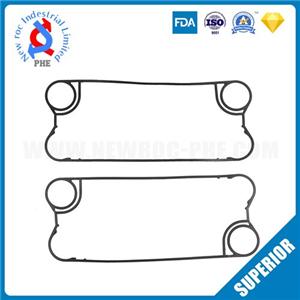Comparison of plate heat exchanger and shell-and-tube heat exchanger
The heat transfer coefficient is high. Because different corrugated plates are inverted each other to form a complicated flow channel, the fluid flows in a three-dimensional rotation in the flow channel between the corrugated plates of the heat exchanger plate, which can be in a low Reynolds number (generally Re=50~ The turbulent flow is generated under 200), so the heat transfer coefficient is high, which is generally considered to be 3 to 5 times that of the shell-and-tube type.
The logarithmic average temperature difference is large, and the end temperature difference is small. In the shell-and-tube heat exchanger, the two fluids flow in the tube side and the shell side respectively. The flow is generally cross-flow, and the logarithmic average temperature difference correction coefficient is small. Heat exchangers are mostly co-current or counter-current flow, and the correction coefficient is usually around 0.95. In addition, the flow of cold and hot fluids in the plate heat exchanger is parallel to the heat exchange surface without bypass flow, so the plate heat exchanger The temperature difference at the end is small, and the heat transfer to water can be lower than 1℃, while the shell-and-tube heat exchanger is generally 5℃.
The plate heat exchanger occupies a smaller footprint, and the plate heat exchanger has a compact structure. The heat exchange area per unit volume is 2 to 5 times that of the shell and tube type. It is not like the shell and tube type that requires a maintenance place for extracting the tube bundle Therefore, the same heat exchange is achieved, and the area of the plate heat exchanger is about 1/5~1/8 of the shell-and-tube heat exchanger.
It is easy to change the heat exchange area or process combination. Just add or reduce a few heat exchanger plates to increase or decrease the heat exchange area; change the heat exchanger plate arrangement or replace several heat exchanger plates, It can achieve the required process combination and adapt to the new heat exchange conditions, and the heat transfer area of the shell-and-tube heat exchanger is almost impossible to increase.
The weight of the plate heat exchanger is lighter. The thickness of the plate heat exchanger of the plate heat exchanger is only 0.4~0.8mm, while the thickness of the heat exchange tube of the shell-and-tube heat exchanger is 2.0~2.5mm. The shell is much heavier than the heat exchanger frame of the plate heat exchanger, and the plate heat exchanger is generally only about 1/5 of the weight of the shell-and-tube type.
Low price Using the same material, under the same heat exchange area, the price of the plate heat exchanger is about 40%~60% lower than that of the shell-and-tube type.
The production of plate heat exchangers is simpler and simpler. The heat transfer plates of plate heat exchangers are processed by stamping, and the heat exchanger gaskets are vulcanized with molds. The degree of standardization is high, and mass production is possible. Shell-and-tube heat exchangers are generally used Handmade.
It is easy to clean and maintain. As long as you loosen the compression bolts, the frame plate heat exchanger can loosen the plate bundle and remove the plates for mechanical cleaning. This is very convenient for the heat exchange process that requires frequent cleaning of the equipment.
The heat loss of the plate heat exchanger is small, and only the heat exchanger frame plate of the plate heat exchanger is exposed to the atmosphere, so the heat dissipation loss can be neglected, and no heat preservation measures are required. The shell-and-tube heat exchanger has a large heat loss and requires a thermal insulation layer.
The capacity is small, 10%-20% of the shell-and-tube heat exchanger.
The pressure loss per unit length is large. Because the gap between the heat transfer surfaces is small and the heat transfer surface has unevenness, the pressure loss is greater than that of the traditional smooth pipe.
Plate heat exchangers are not easy to scale. Due to the full turbulence inside, they are not easy to scale. The scale coefficient is only 1/3~1/10 of shell-and-tube heat exchangers.
The working pressure should not be too high, and the medium temperature should not be too high, as it may leak. Plate heat exchangers are sealed with gaskets. Generally, the working pressure should not exceed 2.5MPa, and the medium temperature should be below 250°C, otherwise it may leak.
Easy to block, because the passage between the plates is very narrow, generally only 2~5mm, when the heat exchange medium contains larger particles or fibrous substances, it is easy to block the passage between the plates




